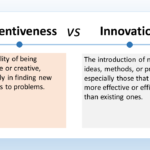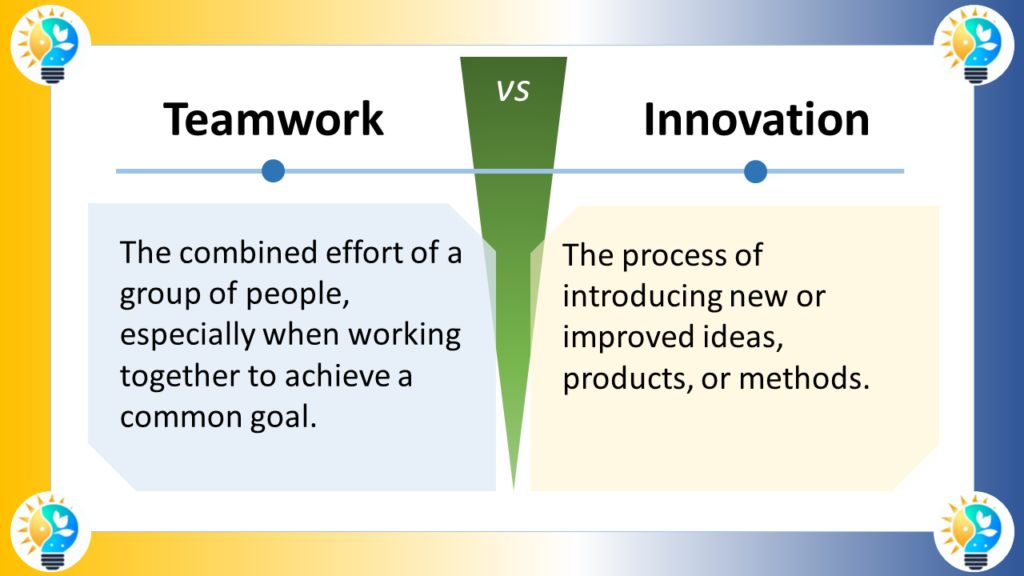Inventiveness is the capacity to devise original solutions to challenges, akin to creativity.
Innovation involves implementing these inventive solutions on a broader scale.
Innovation drives significant change or improvement across various domains by introducing novel approaches or products, often transforming industries or societies through the adoption of inventive or creative solutions.

Innovation and inventiveness are two fundamental concepts that have shaped the world as we know it. They have driven economic growth, improved the quality of life, and solved some of the most pressing challenges facing humanity.
While these terms are often used interchangeably, there are important differences between them that are worth exploring.
Definitions
Innovation refers to the process of introducing new ideas, methods, or products into a market or industry. It involves taking an existing product or process and improving it, or creating something entirely new that meets a specific need or solves a particular problem. Innovation is often focused on creating value for customers, businesses, or society as a whole.
Inventiveness:
Inventiveness, on the other hand, refers to the ability to come up with new ideas or concepts. It is the creative process of generating novel solutions to problems or challenges. Inventiveness is often associated with creativity, imagination, and originality.
More Synonyms on innovation, innovate and innovative
Innovation Terms

Innovation is considered as a driving force in progress.
It includes the introduction of novel ideas, methods, or products that bring positive change and advancement.
For more information about innovations, check our glossary
Innovation vs. Inventiveness: What's the Difference?
At the most basic level, inventiveness refers to the creation of new ideas or concepts, while innovation refers to the implementation of those ideas in a way that creates value. Inventiveness is about coming up with new ideas, while innovation is about putting those ideas into practice.
Inventiveness is often associated with creativity and imagination, while innovation is associated with problem-solving and practical application. Inventors are typically focused on creating new technologies, products, or processes, while innovators are focused on finding ways to use those technologies, products, or processes to create value for customers, businesses, or society as a whole.
The difference between innovation and inventiveness lies in their focus and outcomes. "Inventive" refers to someone who can design new things, display creativity of thought, and come up with something completely new. It is about creating something new and original. On the other hand, "innovative" describes someone who radically improves the design of something, introduces new ideas or ways of doing things, and incorporates changes to existing concepts. Innovation introduces the concept of "use" of an idea or method and causes a change in behavior or interactions. While an invention is usually a "thing," an innovation is usually an invention that leads to a change in behavior or interactions.
Relationship and Relevance
Inventiveness and innovation are interconnected concepts in the creative process. Inventiveness often serves as the foundation for innovation, providing the novel ideas or concepts that can be developed into innovations. However, not all inventive ideas become innovations, and not all innovations require high levels of inventiveness. Innovation takes inventive ideas and transforms them into practical, value-creating realities.
Context for Use
Inventiveness
The term inventiveness is commonly used in:
• Creative problem-solving: Generating unique solutions
• Product design: Conceptualizing new or improved products
• Scientific research: Developing novel hypotheses or methods
• Arts and literature: Creating original works or concepts
Innovation
Innovation is frequently discussed in:
• Business: Developing new products, services, or processes
• Technology: Creating and implementing novel solutions
• Research and development: Turning inventive ideas into practical applications
• Social entrepreneurship: Addressing societal challenges in new ways
Examples
Inventiveness Example
A student designs a conceptual device that can convert ocean waves into drinkable water using a series of unique filtration methods. This showcases inventiveness in addressing a global issue, even if the device hasn't been built or tested yet.
Innovation Example
A company develops and successfully markets a new type of eco-friendly packaging material made from agricultural waste. This innovation takes an inventive idea (using waste as a resource) and implements it to create a practical, marketable product that solves an environmental problem.
The Importance of Inventiveness
Inventiveness is the spark that ignites the flame of progress. Without new ideas and concepts, there would be no innovation. Inventors are the ones who push the boundaries of what is possible, and their contributions have led to some of the most important breakthroughs in history.
Consider the invention of the steam engine, which revolutionized transportation and industry in the 19th century. The steam engine was the result of decades of inventive work by engineers and inventors, who developed new technologies and materials that made the engine possible. Without their inventiveness, the steam engine may never have been created.
The Importance of Innovation
While inventiveness is important, it is only half of the equation. In order to create value and drive progress, new ideas must be implemented in a practical and effective way. This is where innovation comes in.
Innovation is about finding new ways to use existing technologies, products, or processes, or creating new ones that are better, faster, or cheaper. It is about solving problems and creating value for customers, businesses, and society as a whole.
Consider the invention of the smartphone. While the underlying technologies that make smartphones possible have been around for decades, it was the innovative combination of those technologies into a single, user-friendly device that created the smartphone revolution. Today, smartphones are ubiquitous, and they have transformed the way we communicate, work, and live.
Innovation and Inventiveness in Action
To better understand the relationship between innovation and inventiveness, let's look at a few real-world examples.
One example is the electric car. The idea of an electric vehicle has been around for over a century, but it was not until recent years that the technology became practical and affordable. Companies like Tesla have been at the forefront of this innovation, developing new battery technologies, charging infrastructure, and production methods that have made electric cars a viable alternative to traditional gasoline-powered vehicles.
Another example is the development of the COVID-19 vaccine. While the underlying science of mRNA vaccines has been around for decades, it was the innovative application of that science to create a vaccine for COVID-19 that has had a profound impact on the world. Companies like Pfizer and Moderna were able to develop and distribute their vaccines in record time, thanks to innovations in manufacturing, distribution, and logistics.
Conclusion
Innovation and inventiveness are two sides of the same coin. Inventiveness is the spark that ignites the flame of progress, while innovation is the fuel that keeps it burning. By working together, these two forces have the power to transform industries, solve problems, and improve the quality of life for people around the world.
As we look to the future, it is clear that innovation and inventiveness will continue to be driving forces of progress. Whether it is developing new technologies to combat climate change, creating new treatments for diseases, or finding new ways to connect people and communities, the possibilities are endless. By fostering a culture of innovation and inventiveness, we can unlock the full potential of human creativity and ingenuity, and build a better world for all.
FAQ
Q: Can someone be inventive without being innovative?
A: Yes, a person can generate many creative ideas (inventiveness) without necessarily bringing them to practical implementation (innovation).
Q: Is innovation always based on new inventions?
A: Not always. Innovation can also involve finding new applications for existing technologies or combining known elements in novel ways.
Q: How do inventiveness and innovation contribute to progress?
A: Inventiveness provides the creative spark and novel ideas, while innovation turns the most promising of these ideas into practical, impactful realities.
Q: Can innovation occur without inventiveness?
A: While some degree of inventiveness is often involved, innovation can also stem from incremental improvements or novel applications of existing ideas.
References
- Inventive vs. Innovative
- Innovation vs. Invention
- The Difference Between Invention and Innovation
- Are You Inventive or Innovative?
- Innovation vs. Invention


